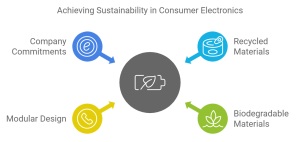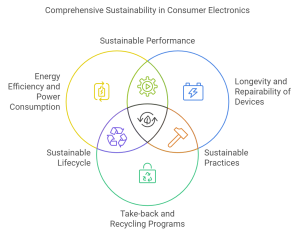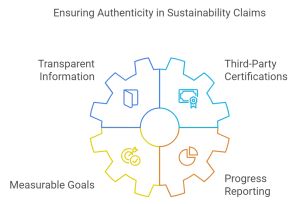By Emma Lester-Devitt, Managing Partner & Co-Founder

Introduction
Imagine walking into an electronics store where every gadget, from smartphones to smart home devices, not only boasts cutting-edge features but also champions environmental responsibility. This scenario is rapidly becoming a reality as the worlds of retail marketing, sustainability, and consumer electronics converge in an unprecedented way. The consumer electronics industry, long associated with rapid technological advancements and planned obsolescence, is undergoing a profound transformation. As climate change concerns intensify and consumers become increasingly eco-conscious, the importance of sustainable practices in this sector has skyrocketed. This shift is not just a passing trend but a fundamental reimagining of how we produce, market, and consume technology.
The Rise of Sustainable Consumer Electronics
Eco-Friendly Materials and Design
The journey towards sustainability in consumer electronics begins at the very foundation: materials and design. Leading brands are now pioneering the use of recycled and biodegradable materials in their products. For instance, Dell has committed to using recycled plastics in its computers, while Apple boasts of using 100% recycled aluminium in the enclosures of several products, including the latest MacBook Air.
Sustainable design goes beyond materials and encompasses a product's entire lifecycle. Companies like Fairphone are revolutionising the industry with modular smartphones designed for easy repair and upgrades, directly challenging the throwaway culture that has long plagued the electronics sector.

Energy Efficiency and Power Consumption
Energy efficiency has become a cornerstone of sustainable consumer electronics. The push for energy-efficient devices is not just about reducing electricity bills; it's a crucial step in minimising the carbon footprint of our digital lives.
Modern electronics now come equipped with a range of energy-saving features:
-
Smart power management systems that optimise energy use based on usage patterns
-
QLED / OLED displays that consume less power than traditional LCD screens
-
Energy-efficient processors that deliver high performance with lower power consumption
For example, the latest generation of smart TVs can reduce their energy consumption by up to 30% compared to older models, thanks to advanced power management and more efficient LED backlighting.
Green Marketing Strategies in Retail
Highlighting Sustainability in Product Messaging
As consumers become more environmentally conscious, brands are adapting their marketing messages to highlight their eco-friendly initiatives. This shift in product messaging goes beyond mere feature lists to tell a compelling story about a product's environmental impact.
Successful green marketing campaigns in consumer electronics often focus on:
-
The use of recycled materials in product manufacturing
-
Energy efficiency ratings and power-saving features
-
Longevity and repairability of devices
-
Take-back and recycling programmes for old electronics

Samsung's "Galaxy for the Planet" initiative is a prime example of effective green marketing. The campaign not only highlights the company's use of recycled materials in its smartphones but also sets ambitious goals for reducing its environmental impact across its entire product line.
Sustainable Packaging and Presentation
The shift towards minimal and recyclable packaging is revolutionising how consumer electronics are presented and sold. Brands are realising that sustainable packaging not only reduces environmental impact but also positively influences consumer perception.
Apple has been at the forefront of this trend, significantly reducing the size of its product boxes and eliminating plastic wrap. This move not only decreases waste but also allows for more efficient shipping, further reducing the carbon footprint of their products.
Retailers are also playing their part by creating dedicated spaces for eco-friendly products and using sustainable materials in their store designs. Best Buy, for instance, has implemented in-store recycling programmes and eco-friendly product labelling to help consumers make informed choices.
The Impact of Sustainability on Consumer Behaviour
Eco-Conscious Purchasing Decisions
Sustainability has become a significant factor influencing consumer choices in electronics. A recent study by Deloitte found that 28% of consumers have stopped purchasing certain brands due to ethical or sustainability-related concerns.
In the realm of consumer electronics:
-
67% of consumers consider sustainability when making a purchase
-
55% are willing to pay more for eco-friendly electronics
-
73% of millennials are willing to pay extra for sustainable offerings
These statistics underscore the growing importance of sustainability in consumer decision-making, particularly among younger generations.
The Role of Education in Sustainable Consumption
Educating consumers about sustainable practices is crucial in promoting eco-friendly behaviour. Retailers and brands are taking on this responsibility through various initiatives:
-
In-store displays explaining the environmental impact of different products
-
Online resources providing tips for extending device lifespan and proper e-waste disposal
-
Partnerships with environmental organisations to raise awareness about sustainable tech use
For example, Currys in the UK launched a "Go Greener" campaign, offering customers advice on choosing energy-efficient appliances and electronics and information on recycling old devices.
Challenges and Opportunities in Sustainable Retail Marketing
Overcoming Greenwashing Concerns
As sustainability becomes a key selling point, the issue of greenwashing – making misleading claims about environmental benefits – has emerged as a significant concern. To maintain authenticity in their sustainability claims, brands should:
-
Provide transparent and verifiable information about their eco-friendly practices
-
Obtain third-party certifications for their sustainability claims
-
Set realistic and measurable sustainability goals
-
Regularly report on progress towards these goals

Balancing Innovation and Sustainability
One of the biggest challenges in the consumer electronics industry is maintaining technological progress while being eco-friendly. However, some brands are successfully striking this balance:
-
Lenovo's ThinkPad line combines cutting-edge technology with a focus on durability and repairability
-
Samsung’s QLED TVs offer state-of-the-art picture quality while consuming less energy than traditional LED TVs
-
Sony's commitment to using recycled plastics in their products without compromising on quality or performance
These examples demonstrate that innovation and sustainability can go hand in hand, offering brands opportunities to differentiate themselves in a crowded market.
The Future of Sustainable Retail in Consumer Electronics
Emerging Technologies and Trends
The future of sustainable consumer electronics is brimming with exciting possibilities:
-
Biodegradable electronics that can decompose safely at the end of their lifecycle
-
Advanced energy harvesting technologies that could power devices using ambient light or heat
-
Artificial Intelligence-driven systems that optimise device performance and energy use
-
Augmented Reality shopping experiences that reduce the need for physical product samples
The Role of Regulations and Standards
Government regulations and industry standards are set to play a crucial role in shaping the future of sustainable electronics. The European Union's "Right to Repair" legislation, for instance, is forcing manufacturers to make their products more repairable and long-lasting.
These regulations will likely impact retail marketing strategies, with a greater emphasis on repairability, longevity, and end-of-life recycling in product messaging and retail displays.
Conclusion
The convergence of retail marketing, sustainability, and consumer electronics is not just reshaping an industry – it's redefining our relationship with technology. As we've explored, from eco-friendly materials and energy-efficient designs to green marketing strategies and shifting consumer behaviours, sustainability is now at the heart of the consumer electronics landscape.
The challenges are significant, but so are the opportunities. Brands that can authentically embrace sustainability, balancing it with innovation and performance, will be well-positioned to thrive in this new era. As consumers, we have the power to drive this change further by making informed, eco-conscious decisions in our tech purchases.
The future of retail marketing in consumer electronics is unequivocally green. It's a future where our gadgets not only enrich our lives but also contribute to a healthier planet. As we move forward, let's embrace this sustainable revolution, choosing products that reflect our values and support brands that are committed to making a positive impact.
Remember, every purchase is a vote for the kind of world we want to live in. The next time you're in the market for a new electronic device, consider its environmental impact alongside its features.
Together, we can build a more sustainable future, one device at a time.
Follow us on LinkedIn for our latest news.